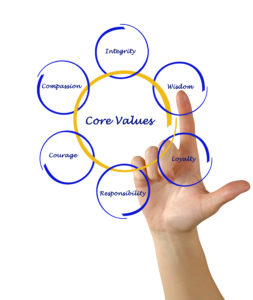Resilience 101
“More than education, more than experience, more than training, a person’s level of resilience will determine who succeeds and who fails. That’s true in the cancer ward, it’s true in the Olympics, and it’s true in the boardroom.” Dean Becker, CEO Adaptiv Learning Systems
Emotional resilience is incredibly important to health, happiness, and success. If you are looking for professional success- resilience is one of the qualities shared by the super achieving elite (think Steve Jobs, Bill Gates, or Michael Phelps). Want to be healthier? Stress contributes to health problems including heart failure, weight gain, and insomnia and emotional resilience decreases stress.
What is resilience? More importantly, how do I become resilient?
At its core, emotional resilience is simply the ability to bounce back from the inevitable challenges of life. Ok, theoretically that makes sense but it does beg the question, HOW?
In researching the notion of resilience, I’ve found a set of characteristics that consistently appear. The three most common traits that resilient people share are:
- Brutal acceptance of reality
- An inherent belief that life is meaningful
- A gift for improvisation (working with what is in front of you)
I am going to frame the goal of building resilience around these shared attributes.
A Case Study-Resilience in Real Life
Recently a client contacted me for organizational coaching. Let’s call him Ryan. He was unhappy with how his workday flowed and wanted to make some changes.
He works for a multi-millionaire managing all aspects of the home, financial assets, personnel, and investment properties for his boss. Needless to say, he is stressed all the time.
Turns out, there was a pattern to his days. The moment he walked in the door, his team, his contractors, and his boss would bombard him with multiple grievances, problems, and concerns. It was loud, angry, volatile and chaotic. Day in and day out, he was unable to rebound from that initial insult. He carried that emotional and disruptive climate with him throughout his day.
To further complicate the situation, he was exerting a massive amount of energy to ignore or minimize the reality of that toxic beginning. He rationalized it in a variety of ways: “This was a one time issue.” “Not all of my mornings start badly.” “Most days are pretty smooth.”
No amount of rationalization could address the profound emotional effects he felt. His work-life balance was wildly out of whack. His personal life was suffering. He was exhausted and burned out.
What to do?
The PLAN
1. Identify the Reality
Ryan needed a reality check. His well-intended effort to make the best of a bad situation was not serving him well. Once he identified the problem, it became a manageable entity. “My day regularly starts with volatility and chaos.” Reality isn’t always pretty, but it gave Ryan freedom to have a different perspective on the issue. Instead of stress with no discernible cause, he now had a quantifiable and fixable root cause.
Our minds are powerful. What we believe to be true is true. Look at the stressors you tend to carry. If you are stressed, is there something that always pops up on the list? Are you ‘stressing’ over something completely out of your control.
2. Understand Your Values-What Makes Your Life Meaningful?
The belief that life is meaningful comes from your unique set of values. Your values provide the lens and filter through which you understand your life. Emotional resilience comes out of clarity about your values- the unique and personal internal compass you use to help navigate your life.
What REALLY matters to you? Do you value honesty? Do you value extravagance? Do you value peace? Humor? Logic? Righteousness? Sometimes our values get cloudy. Our family and friends challenge them. Our culture and society challenge them. It is important to understand what matters to you. Make a list of every possible thing you care about. Then narrow it down to 10. Those ten values can act as a great compass. When you find yourself struggling, take a step back, and re-evaluate the situation. Walk through the checklist. Is the problem real? Is it affecting something that you truly value?
In our work together, Ryan clearly realized that he valued Peace and Competence immensely. Beginning his day with conflict and alarm was especially jarring for him. In a sense, his internal compass was knocked so askew that he became so unmoored that he was unable to creatively problem solve.
3. Create Systems
When you have identified the trouble spots, you can set up effective work-arounds. Systems do not have to be complicated. For Ryan, it was very simple. Though he arrived to work at 9, he asked his assistant to hold all calls and meetings until 9:30. This gave him time to mentally prepare for the onslaught. After his morning debriefs were over, he asked his assistant to hold everything for ten minutes, allowing him to reset. Even a simple system goes a long way towards facilitating emotional resilience.
4. Get Inventive/Improvise
Remember Midas? Everything he touched turned to Gold. Be Midas. No matter what lands in hands, work with it. Turn even the most smelly s*&t into gold.
In a South Texas drawl, “should” sounds an awful lot like s*&t. A friend of mine says “Be careful throwing ‘should’ around, or you’re gonna have a lot of ‘should’ to pick up.” “Should” is a terrible word when you are trying to build resilience.
Ryan practices improvising daily. His job is putting out fires. He thought he had a meeting at 10, but the client was 30 minutes late. He’s learned to work with what he has. Remember the expression “necessity is the mother of invention”? So true. When you are hit with what feels like a bomb, get inventive. Get comfortable in the moments when nothing is going according to plan.
5. Have Fun/Be Kind to Yourself
 Be willing to negotiate unexpected roadblocks with humor. One thing I share with Ryan is that I take myself WAY too seriously. If you can see the humor in the unexpected, the hilarity in the drama, it becomes much easier to bounce back from the things that whack us.
Be willing to negotiate unexpected roadblocks with humor. One thing I share with Ryan is that I take myself WAY too seriously. If you can see the humor in the unexpected, the hilarity in the drama, it becomes much easier to bounce back from the things that whack us.
Give yourself a break. Much of the stress you feel is self-inflicted. Stress a part of life. But how we look at it can affect the way we navigate it. When Ryan realized that his anxiety and stress had a source, he could stop beating himself up over his hard charging workday. He learned to be more creative, flexible, and resilient.
Remember, anxiety and stress create the exact same physiologic response as excitement. (Heart beating hard, palms sweaty, flushing.) The ONLY difference is the internal story we are telling ourselves. Tell yourself a good story!
In the End…
Building Emotional Resilience is possible. It is like working out a muscle. And just as with any exercise program, there are resources to help. Drop us a line and we can connect you with the right resource for you.
Falls are inevitable. Failure is guaranteed. But in the midst of the fall and the failure, remember what Vivian Komori wrote. “Life is not about how fast you run or how high you climb, but how well you bounce.”


